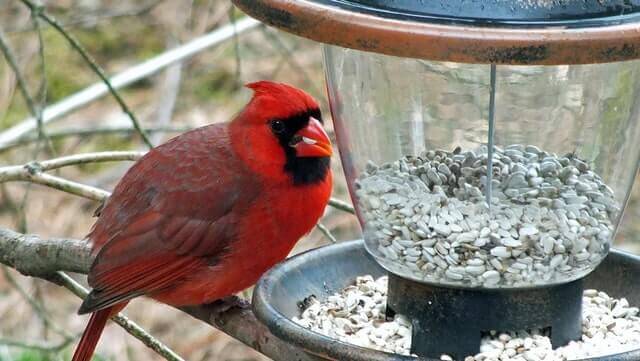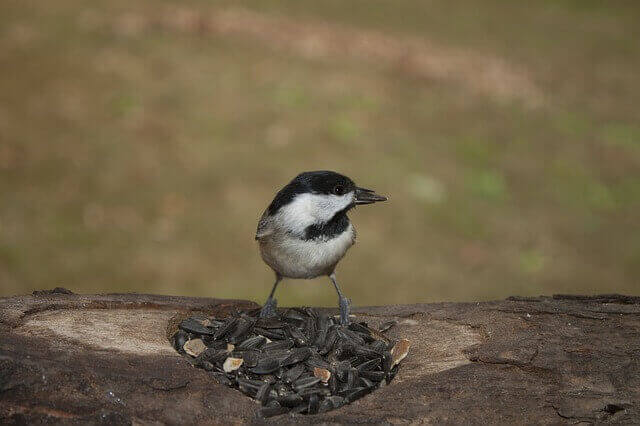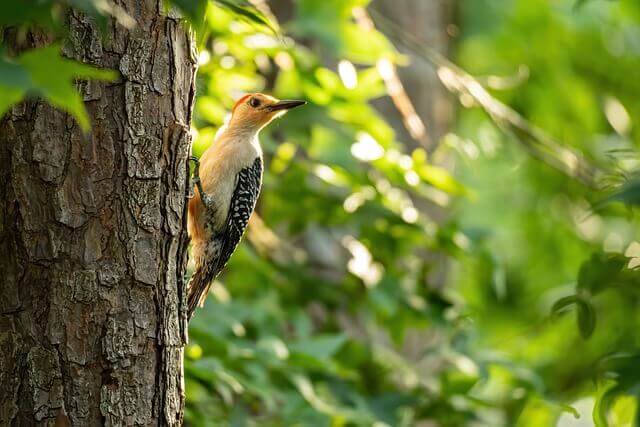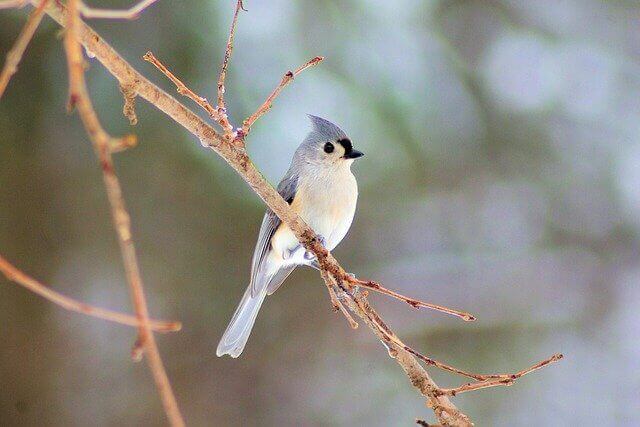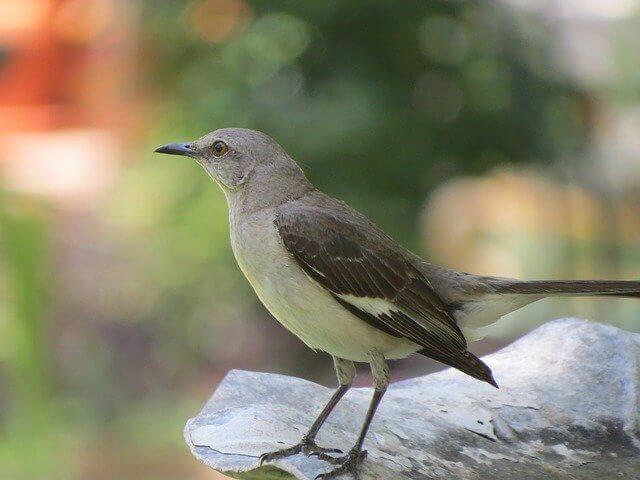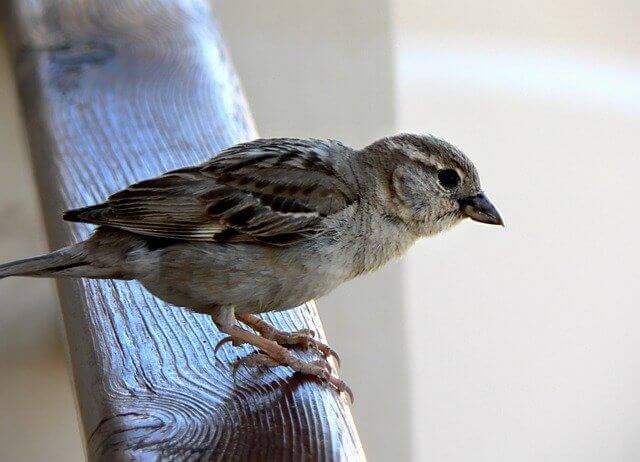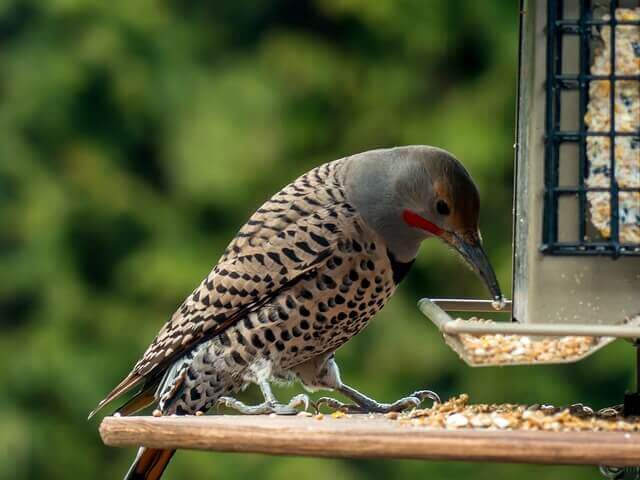Maryland’s diverse habitats, from Chesapeake Bay marshes to Appalachian forests, make it a hotspot for birdwatching. In this comprehensive guide, we’ll introduce you to the 58 most common birds you can find in Maryland.
Dive into their unique habitats, behaviors, and prime spotting locations across the state, making this your go-to resource for birdwatching adventures.
Table of Contents
- 1 Most Common Birds In Maryland
- 1.1 Northern Cardinal
- 1.2 Carolina Wren
- 1.3 American Crow
- 1.4 Blue Jay
- 1.5 Mourning Dove
- 1.6 Carolina Chickadee
- 1.7 American Robin
- 1.8 Red-bellied Woodpecker
- 1.9 Tufted Titmouse
- 1.10 American Goldfinch
- 1.11 Downy Woodpecker
- 1.12 European Starling
- 1.13 Song Sparrow
- 1.14 Red-winged Blackbird
- 1.15 White-throated Sparrow
- 1.16 Northern Mockingbird
- 1.17 White-breasted Nuthatch
- 1.18 House Finch
- 1.19 Eastern Bluebird
- 1.20 Common Grackle
- 1.21 House Sparrow
- 1.22 Northern Flicker
- 2 Frequently Asked Questions
- 3 Author
Most Common Birds In Maryland
Northern Cardinal
The red cardinal is a common North American bird. Its range extends from southern Canada into northern Mexico. The bird is most commonly found in woodlands, but can also be found in open areas such as fields and gardens.
The diet of the Northern Cardinal consists mainly of insects and seeds. The bird will also eat berries and fruits when they are available. The Northern Cardinal is a very popular bird, and its bright red plumage makes it easy to identify.
- Frequency: 60.64% (Statistic: eBird)
- Color: Mostly red with a black mask on the face, short pink bill
- Habitat: woodlands, gardens, parks, backyards, and wetlands
- Range: USA, Canada, Mexico
- Size: 8.2 – 9.3″ inches
- Weight: 33 – 65 grams
- Diet: Fruits, berries, and insects (grasshoppers, beetles, snails, cicadas)
- Family: Cardinalidae
- Genus: Cardinalis
- Maps: Range Map – Sightings Map
- Sounds: Calls and Songs
Related:
- 10 Best Bird Feeders for Cardinals (Rated for 2022)
- Where are Cardinal Birds Found – Best Places to Look
- Cardinal Bird Facts You Never Knew
Carolina Wren
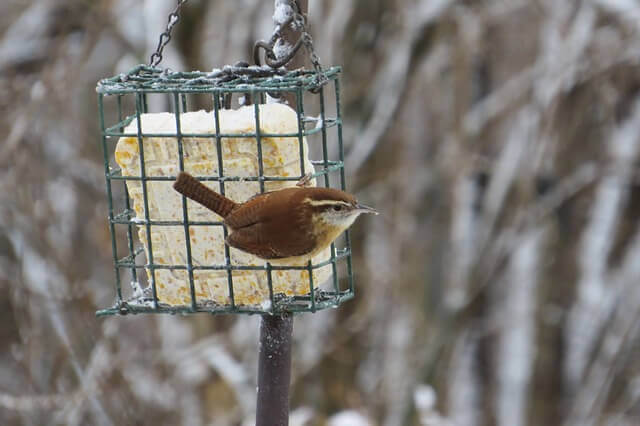
The Carolina Wren is a small songbird that ranges throughout the southeastern United States. They are commonly found in woodlands, but can also inhabit urban and suburban areas. Carolina Wrens are omnivorous, eating a variety of insects, spiders, and berries. Carolina Wrens are small songbirds with a body length of 4-5 inches and a wingspan of 7-8 inches.
They are brownish above and rusty orange below, with a white stripe over their eyes. Males and females look similar, but the male has a slightly longer tail. Carolina Wrens are found in the southeastern United States, from Virginia to Florida and west to Texas. They prefer woodlands with dense understory cover, but can also be found in urban and suburban areas.
- Frequency: 48.29%
- Color: Black cap and throat with white cheeks. Light gray wings, back, and tail.
- Habitat: Deciduous forests, suburbs, parks, backyards
- Range: USA ( Texas, Florida, New Jersey, and Kansas)
- Size: 4.5 – 5.1″ inches long
- Weight: 9 – 12 grams
- Diet: Insects, berries, seeds
- Family: Paridae
- Genus: Poecile
- Maps: Range Map – Sightings Map
- Sounds: Calls and Songs
Related: How to Attract Wrens to your Backyard? (Expert’s Guide)
American Crow
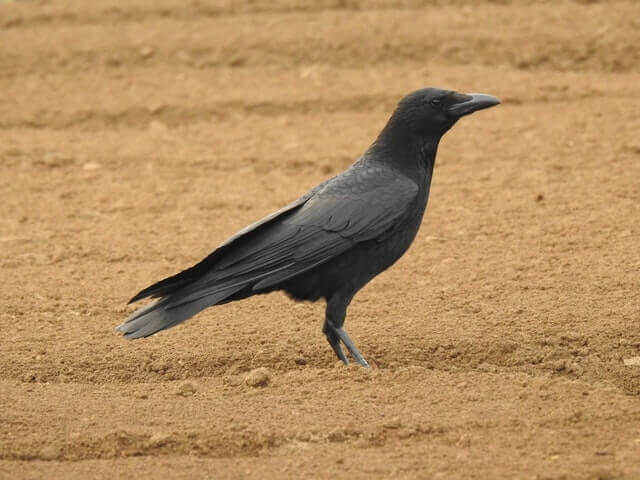
The American Crow is an extraordinary passing passerine bird species of the genus Corvus. It is an extremely common bird found across much of North America, being the main species in the far southern states from Texas southward to upper portions of central Mexico.
Like most crows, the American Crow has a wide range of dietary habits, feeding on a variety of foods, including fish, algae, seeds, worms, and carrion. The most important habitat for the American Crow is in marshlands and thickets, probably they are attracted to marshes and fields in which they hunt.
- Frequency: 42.65%
- Color: Black
- Habitat: Open country, farms, parks, woodlands, towns, cities
- Range: Canada, USA, Mexico
- Size: 16 – 21″ inches
- Weight: 315 -620 grams
- Diet: invertebrates, carrion, seeds, eggs fish, grains, mice, frogs, and other small animals.
- Family: Corvidae
- Genus: Corvis
- Maps: Range Map – Sightings Map
- Sounds: Calls and Songs
Related: How To Attract Crows To Your Backyard: Expert Tips!
Blue Jay
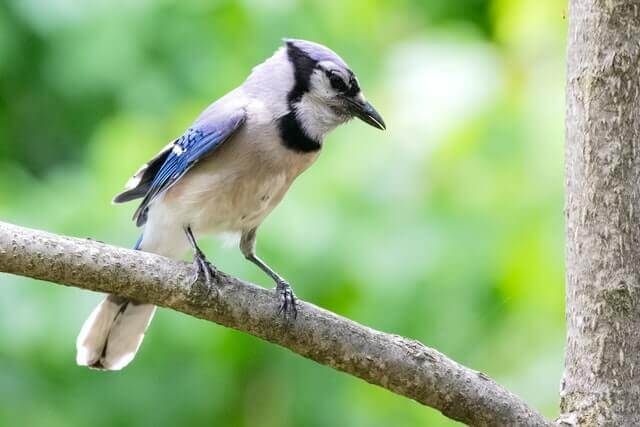
Blue jays are native to North America and are most commonly found in the eastern parts of the continent. They are also known to inhabit some parts of the western United States, as well as parts of Canada. The blue jay typically prefers to live in areas with a lot of trees, such as forests or woodlands. They will also sometimes live in urban areas, as long as there are enough trees for them to build their nests.
The blue jay is a very adaptable bird and can live in a variety of different habitats. The blue jay has a very diverse diet and will eat a wide variety of different foods. Their diet consists mostly of insects, but they will also eat nuts, berries, and other small fruits. They have been known to steal food from other animals, such as squirrels.
- Frequency: 42.50%
- Color: Blue crest on the head, wings, back, and tail, and has a white face and belly
- Habitat: Deciduous and mixed forests, mixed woodlands, backyards, parks
- Range: Southern Canada, Eastern and Central United States, Florida and Texas
- Size: 8 – 12″ inches
- Weight: 70 – 100 grams
- Diet: Nuts, seeds, caterpillars, grasshoppers, and beetles
- Family: Corvidae
- Genus: Cyanocitta
- Maps: Range Map – Sightings Map
- Sounds: Calls and Songs
Related:
- How to Attract Blue Jays to your Yard?
- 15 Best Bird Feeders For Blue Jays (Tried & Tested 2022)
- Do Blue Jays Migrate? The Truth
- What do Blue Jay Eat – All The Facts
Mourning Dove
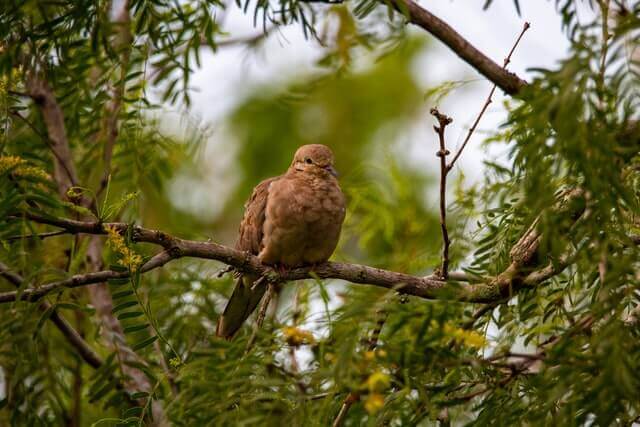
Mourning doves (Zenaida macroura) are among the most common birds found in North America. They get their name from the soft cooing sound they make, which is often heard at dawn and dusk. Mourning doves are gentle creatures that can be found in a variety of habitats, including forests, fields and even urban areas. These birds are mostly gray, with a white underside and black spots on their wings.
Mourning doves typically eat seeds and fruits, but they will also consume insects on occasion. These birds usually mate for life and build nests made of twigs and grasses in trees or bushes. Mourning doves are not considered to be endangered at this time, but their populations have declined in recent years due to habitat loss and hunting pressure.
- Frequency: 42.54%
- Color: Light gray-brown and lighter and pinkish below. The wings have black spots.
- Habitat: Open habitats, urban areas, farms, prairie, grassland, wooded area
- Range: USA, Canada, Mexico, Central America, Greater Antilles
- Size: 12″ inches length
- Weight: 112 – 170 grams
- Diet: Rapeseed, corn, millet, safflower, sunflower seeds, pokeberry, sesame, and wheat.
- Family: Columbidae
- Genus: Zenaida
- Maps: Range Map – Sightings Map
- Sounds: Calls and Songs
Related: Facts About Mourning Doves – 10 Things You Need To Know!
Carolina Chickadee
The Carolina Chickadee is a small, sprightly bird that is common in woodlands throughout the southeastern United States. The Carolina Chickadee has a black cap and bib with white sides to its face. Its back and underparts are gray, and it has a wingspan of about 9 inches. The Carolina Chickadee is a non-migratory bird, spending its entire life within a relatively small range.
The Carolina Chickadee is found in woodlands, including both deciduous and evergreen forests. It is also often seen in urban areas, such as parks and gardens. The Carolina Chickadee requires thick vegetation for nesting and roosting cover, as well as access to trees with cavities for nesting sites. The diet of the Carolina Chickadee consists primarily of insects, although it will also eat seeds and berries.
- Frequency: 46.98%
- Color: Black cap and throat with white cheeks. Light gray wings, back, and tail.
- Habitat: Deciduous forests, suburbs, parks, backyards
- Range: USA (Texas, Florida, New Jersey, and Kansas)
- Size: 4.5 – 5.1″ inches long
- Weight: 9 – 12 grams
- Diet: Insects, berries, seeds
- Family: Paridae
- Genus: Poecile
- Maps: Range Map – Sightings Map
- Sounds: Calls and Songs
Related: Carolina Chickadees – 9 Best Ways To Attract Them Fast!
American Robin
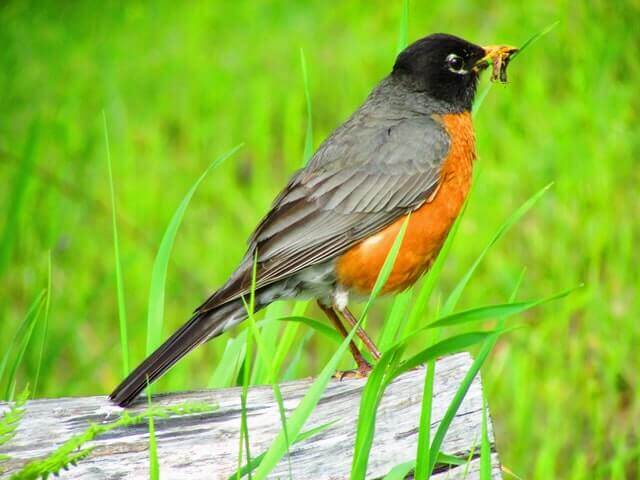
The American Robin has a large range of natural habitat across eastern North America, including the lower Mississippi River and several rivers and streams in southern Indiana, eastern Nebraska, and southward to Texas. It also winters in southern Oregon, California, and Washington. It feeds on a wide variety of berries, leaves, seeds, grasses, insects, and carrion.
The berries it prefers are blueberries, strawberries, raspberries, and blackberries. Nests can be found in fields, brush, junkyards, fields, near roads and railways, parks, and backyards. The American Robin will nest near plants and trees and sometimes in houses, caves, and burrows dug by the birds.
- Frequency: 51.76%
- Color: Mostly brown on the back with an orange colored breast
- Habitat: Wooded areas, backyards, parks, fields
- Range: USA, Canada, Mexico
- Size: 12 – 16″ inches
- Weight: 72 – 95 grams
- Diet: Fruits, berries and insects (earthworms, beetles, caterpillars
- Family: Turdidae
- Genus: Turdus
- Maps: Range Map – Sightings Map
- Sounds: Calls and Songs
Related:
- How To Attract Robins To Your Yard – 7 Best Tips!
- 5 Best Bird Feeders For Robins (Tested & Rated For 2022)
- Interesting American Robin Fun Facts
Red-bellied Woodpecker
The Red-bellied Woodpecker is a common woodpecker of the eastern United States. This species ranges from southern Canada to northern Florida, and west to central Texas and southeastern Arizona. It is a permanent resident throughout its range, although some northern birds may move south in winter.
This bird is found in both deciduous and coniferous forests, as well as mixed woodlands. It often forages on trees in suburban areas and parks. They feed on a variety of foods including termites, beetles, grasshoppers, midges, ground beetles, moths, earthworms, roaches, and spiders.
- Frequency: 38.73%
- Color: Gray on body and face and underparts. Black and white pattern on wings, back, and tail.
- Habitat: Forests, backyards
- Range: Southern Canada, Eastern United States, Florida
- Size: 9 – 10.6″ inches long
- Weight: 56 -91 grams
- Diet: Insects, tree frogs, eggs of small birds, oozing sap, and small fish.
- Family: Picidae
- Genus: Melanerpes
- Maps: Range Map – Sightings Map
- Sounds: Calls and Songs
Related: How to Attract Red-bellied Woodpeckers to your Yard?
Tufted Titmouse
The Tufted Titmouse is a small songbird that ranges throughout the eastern United States, from Maine to Florida and west to Texas. The Tufted Titmouse has a body length of 5 to 6 inches. It has gray upperparts and whitish underparts. Its most distinguishing feature is the tuft of black feathers on its head.
Its habitat includes woodlands, gardens, and parks. It is a common bird at backyard bird feeders. The diet of the Tufted Titmouse consists mainly of insects and seeds. In winter, its diet also includes fruits and nuts.
- Frequency: 43.42%
- Color: Gray upper, white front, a tufted gray crest on the head
- Habitat: Deciduous forests, river basin, backyards, swamps
- Range: Canada, USA, and Mexico
- Size: 5.5 – 6.4″ inches
- Weight: 18 – 26 grams
- Diet: Nuts, insects, berries, seeds small fruit, and snails
- Family: Paridae
- Genus: Baeolophus
- Maps: Range Map – Sightings Map
- Sounds: Calls and Songs
Related: How to Attract Tufted Titmouse to my Yard
American Goldfinch
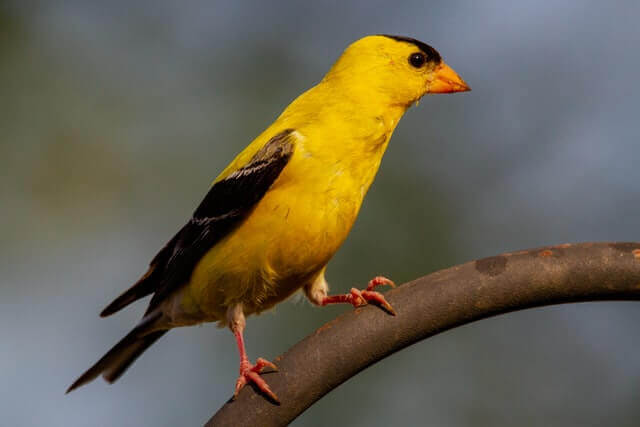
The American Goldfinch is a small songbird that ranges across North America. It is most commonly found in open woodlands and edges, as well as in fields and meadows. The diet of the American Goldfinch consists primarily of seeds, although they will also eat insects during the nesting season.
American Goldfinches are social birds that often form flocks outside the breeding season. They are one of the few North American bird species that actually increase in numbers during the winter months. While they are not typically considered to be migratory birds, some populations do move south during the winter.
- Frequency: 39.28%
- Color: Face, neck, and underside are yellow, black wings with white bars
- Habitat: Deciduous forests and thickets, roadside, grasslands, backyards, meadows
- Range: Canada, USA and Mexico
- Size: 4.3 – 5.5″ inches length
- Weight: 12 -18 grams
- Diet: Grass, dandelions, chickweed, sunflowers and ragweed, thistle, red alder, birch, spruce seeds
- Family: Carduelinae
- Genus: Spinus
- Maps: Range Map – Sightings Map
- Sounds: Calls and Songs
Related: American Goldfinch Interesting Facts
Downy Woodpecker
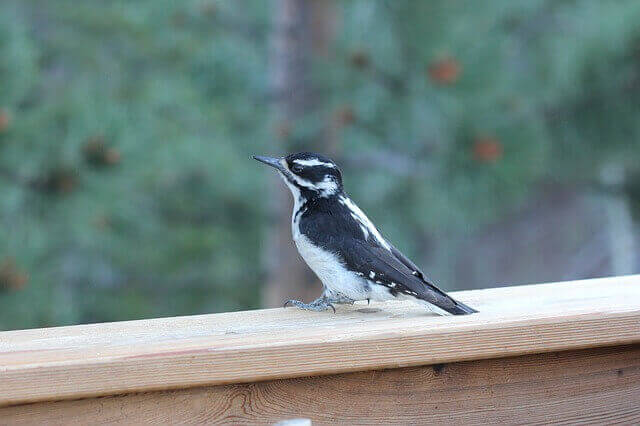
The Downy Woodpecker (Picoides pubescens) is a small woodpecker found in North and Central America. The Downy Woodpecker has a wide range, extending from Alaska and Canada down through the United States to Mexico. These birds are not migratory, so they can be seen in their range all year round. These birds are most often seen in deciduous forests, but they can also be found in other habitats such as coniferous forests, orchards, parks, and residential areas.
The diet of the Downy Woodpecker consists mainly of insects and spiders, which they find by pecking at tree bark or picking through leaves. These birds will also eat berries and other fruits when they are available. The Downy Woodpecker is an important part of the ecosystem as it helps to control insect populations.
- Frequency: 36.88%
- Color: Black with a white throat, belly, and back. White spots on wings
- Habitat: Deciduous forests and thickets, roadside, grasslands, backyards, parks
- Range: Canada, USA, and Mexico
- Size: 5.5 – 7.1″ inches in length
- Weight: 20 – 33 grams
- Diet: Mostly insects and beetles and ants, also gall wasps, caterpillars
- Family: Picadae
- Genus: Dryobates
- Maps: Range Map – Sightings Map
- Sounds: Calls and Songs
Related: How to Attract Downy Woodpeckers to Your Yard? (Easy!)
European Starling
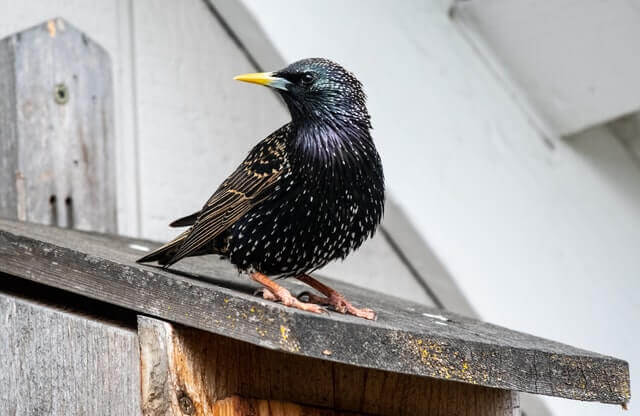
The European Starling is a small to medium-sized passerine bird that belongs to the family of Sturnidae. The bird is also known as the common starling, or simply the starling. The species was first described by Linnaeus in his 1758 work Systema Naturae. The binomial name derives from the Latin words sturnus meaning “starling” and vulgaris meaning “common”.
The European Starling has a cosmopolitan range and is found in most of Europe, Asia, and parts of Africa. It is also a resident breeder in North America, where it is commonly referred to as the Common Starling. The bird’s habitat includes open woodlands, farmlands, gardens, and urban areas. The European Starling feeds on insects, earthworms, berries, and fruits.
- Frequency: 40.66%
- Color: Black with glossy iridescence plumage
- Habitat: Forests, woodlands, backyards, edges, yards, and parks
- Range: North America, Europe, Africa, India, Middle East, China
- Size: 7 – 9″ inches long
- Weight: 60 – 100 grams
- Diet: Insects (ants, beetles, invertebrates), fruits, seeds, berries
- Family: Sturnidae
- Genus: Sturnus
- Maps: Range Map – Sightings Map
- Sounds: Calls and Songs
Related: How To Attract European Starlings To Your Yard Fast?
Song Sparrow
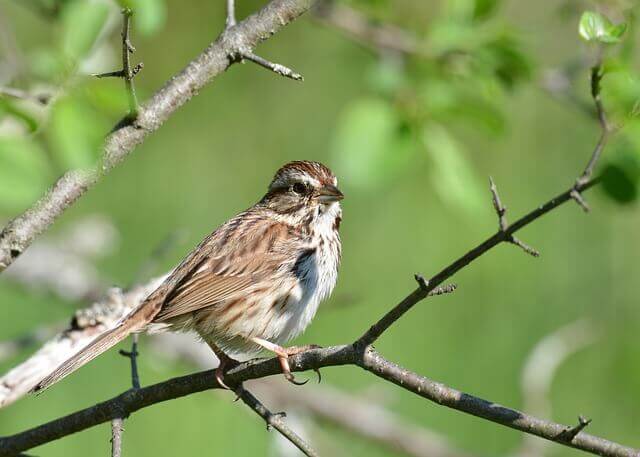
The song sparrow (Melospiza melodia) is one of the most widespread and familiar birds in North America. It is a small sparrow with streaked brown plumage, a whitish breast, and a long, brown tail. The song sparrow is found in nearly all habitats across the continent, from urban parks to Arctic tundra. The main component of its diet comprises insects and seeds.
The song sparrow is a very adaptable bird, able to live in a wide variety of habitats. It is often found in open areas such as fields or meadows, but can also be found in forests, deserts, and even near human settlements. The bird’s diet also varies depending on its habitat; in some areas it may eat mostly insects while in others it may feed primarily on seeds.
- Frequency: 36.64%
- Color: Gray head, white cheek, a black bib, rufous neck
- Habitat: Urban centers, farms, backyards, edges, yards, and parks
- Range: Europe, Mediterranean, Asia, Australasia, Africa, and the Americas
- Size: 5.5 – 7.0″ inches
- Weight: 25 – 40 grams
- Diet: Grains, seeds, and insects
- Family: Passeridea
- Genus: Passer
- Maps: Range Map – Sightings Map
- Sounds: Calls and Songs
Related: How to Attract Sparrows to your Backyard
Red-winged Blackbird
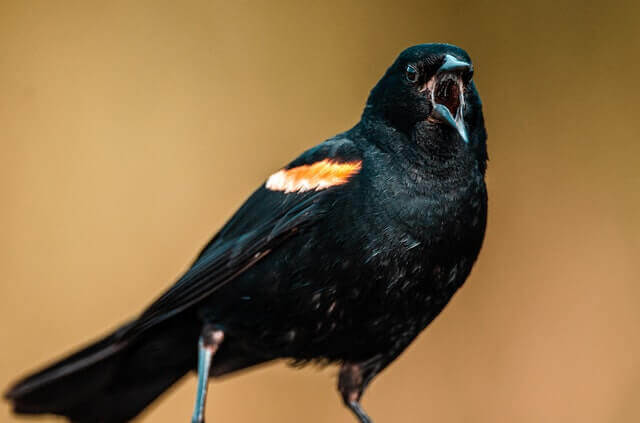
Most species of the Red-winged Blackbird are diurnal, spending most of their time flying over open plains and meadows in search of food. They have powerful wings that enable them to fly quickly and make high flights over swamps and tall grassy areas in search of insects. They can stay aloft for several hours feeding on nearly anything.
The red-winged blackbird likes to hang around meadows and marshes where they hunt for food. Hikers and backpackers can observe these birds in open meadows and tall grassy areas. The Red-winged Blackbird can be seen throughout the year, especially during early spring and early fall when they nest in huge numbers.
- Frequency: 33.59%
- Color: All black with red patches on shoulder and a yellow wing bar
- Habitat: Deciduous forests, conifers, roadside, rivers, backyards, parks
- Range: North America, Central America
- Size: 6.7 – 7.1″ inches length
- Weight: 41.5 – 65 grams
- Diet: Seeds and insects (butterflies, dragonflies, moths, frogs, worms, spider, snails, carrion, flies.)
- Family: Icteridae
- Genus: Agelaius
- Maps: Range Map – Sightings Map
- Sounds: Calls and Songs
White-throated Sparrow
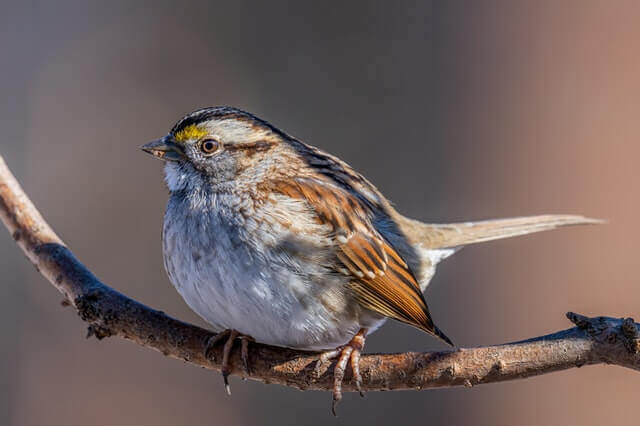
The White-throated Sparrow (Zonotrichia albicollis) is a small sparrow with a light brown back, white underparts, and a distinctive white throat and yellow spot above the eye. It breeds in open woodlands across Canada and the northern United States. The White-throated Sparrow is a permanent resident in some parts of its range, but most birds migrate south to spend the winter in the southern United States.
The White-throated Sparrow is found in a variety of habitats, including forests, brushy areas, and even gardens. The bird typically forages on the ground for seeds, insects, and other small invertebrates. The White-throated Sparrow often feeds alongside other sparrows, such as the Song Sparrow (Melospiza melodia). The White-throated Sparrow is relatively common and has a large range.
- Frequency: 25.87%
- Color: Brown and gray head pattern. Black-and-white-striped head, white throat, and yellow near the eye.
- Habitat: Deciduous forests and thickets, roadside, grasslands, backyards
- Range: Eastern North America, Atlantic Canada
- Size: 5.9″ – 7.5″ inches long
- Weight: 22 – 32 grams
- Diet: Seeds, insects, and berries
- Family: Passerellidae
- Genus: Zonotrichia
- Maps: Range Map – Sightings Map
- Sounds: Calls and Songs
Northern Mockingbird
The Northern Mockingbird is a grayish-brown bird with white patches on its wings and tail. It has a long beak that it uses to eat insects. This songbird can be seen throughout North America. The range of the Northern Mockingbird extends from southern Canada to northern Mexico. The habitat includes forests, woodlands, and urban areas. The diet of the Northern Mockingbird consists of insects and berries.
This bird is common in urban areas, where it can be seen perched on telephone wires or flying from tree to tree in search of food. In forested areas, the Northern Mockingbird typically nests in trees or shrubs. The Northern Mockingbird is an accomplished singer and can mimic the sounds of other birds and animals.
- Frequency: 24.14%
- Color: Gray upper with white underparts. Black and white wing bars.
- Habitat: Forested areas, parks, and gardens
- Range: Southeastern Canada, USA, Northern Mexico, Cayman Islands, Greater Antilles
- Size: 8.0 – 11″ inches long
- Weight: 40 – 58 grams
- Diet: Berries, fruits, seeds, arthropods, earthworms, and occasionally lizards
- Family: Mimidae
- Genus: Mimus
- Maps: Range Map – Sightings Map
- Sounds: Calls and Songs
Related: How to Attract Mockingbirds to your Yard? (Expert Tips)
White-breasted Nuthatch
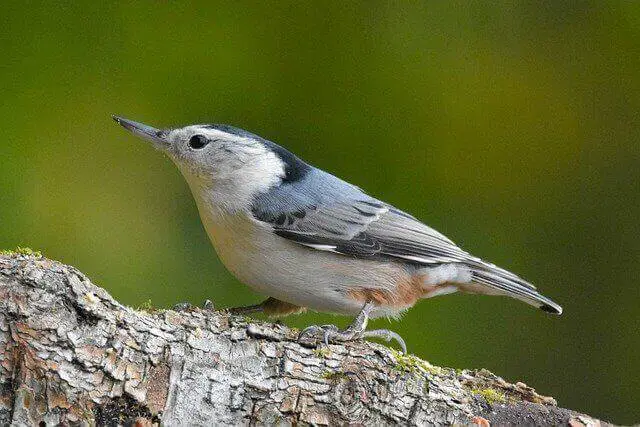
The White-breasted nuthatch is a small, black-capped bird with a white face. It has a blue-gray back and wings, and a gray tail. The belly and breast are white, and the flanks are pale gray. The bill is gray, and the legs and feet are black. Males and females look alike.
The White-breasted Nuthatch is found in North America east of the Rocky Mountains. It is common in forests, especially deciduous woods. It is also found in parks and gardens. The White-breasted Nuthatch eats insects and nuts. It climbs up tree trunks head first to find food. It stored food in crevices in trees to eat later.
- Frequency: 26.83%
- Color: Has a white face, flanks, and chest. It has a black cap on its head a bluish-gray upper and a brown belly
- Habitat: Deciduous forests, conifers, roadside, rivers, backyards, parks
- Range: Southern Canada, USA
- Size: 5.9″ inches
- Weight: 20 grams
- Diet: Acorn nuts, hickory nuts, ants, caterpillars, scale insects, pine weevils
- Family: Sittidae
- Genus: Sitta
- Maps: Range Map – Sightings Map
- Sounds: Calls and Songs
Related: How to Attract Nuthatches to your Backyard
House Finch
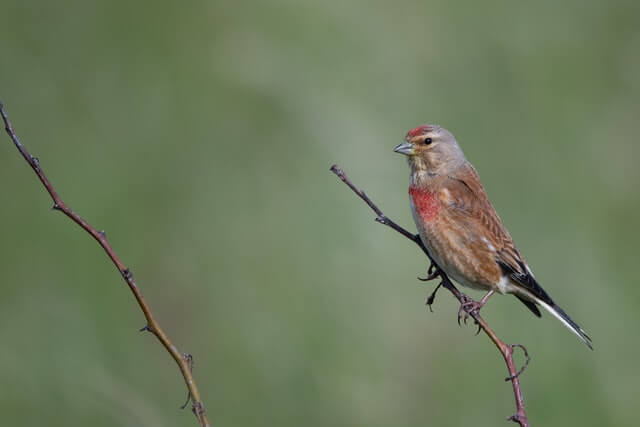
The beautiful House Finch is a popular bird found all across North America. Though they are not migratory, they will travel to find food and nesting sites. The males are a bright red, while the females are a more subdued brown. Both sexes have streaked brown markings on their wings and tails.
These birds are found in open woodlands, gardens, and suburban areas. They prefer to build their nests in trees or shrubs, but will also use man-made structures like eaves and gutters. Their diet consists mostly of seeds and berries, but they will also eat insects.
The House Finch is a lovely bird that is easy to spot in its natural habitat. With a little luck, you may even get to see one up close!
- Frequency: 24.23%
- Color: Reddish face and upper breast, brown streaks on back, belly, and tail.
- Habitat: urban and suburban areas, backyards, edges, yards, and parks
- Range: Canada, USA, Mexico
- Size: 5 – 6″ inches
- Weight: 16 – 27 grams
- Diet: Aphids, grains, seeds, berries, nettle, dandelion, sunflower
- Family: Fringillidae
- Genus: Haemorhous
- Maps: Range Map – Sightings Map
- Sounds: Calls and Songs
Related: How to Attract House Finch to Your Yard?
Eastern Bluebird

The Eastern Bluebird is a small thrush found in forests, fields and gardens. They are migratory birds, spending the winters in the southern United States and the summers in Canada. The diet of the Eastern Bluebird consists of insects and berries. The range of the Eastern Bluebird extends from southeastern Canada to central Mexico.
The habitat of this bird is typically open areas with some trees nearby. In recent years, however, they have increasingly been found in urban areas as well. The diet of the Eastern Bluebird primarily consists of insects such as beetles and caterpillars. However, during the winter months when insects are scarce, they will also eat berries.
- Frequency: 21.67%
- Color: Has a blue head, back, and wings with a reddish-brown breast.
- Habitat: Open woodlands, farmlands, and orchards.
- Range: Southern Canada to the Gulf states, East of the Rockies and south to Arizona to Nicaragua.
- Size: 5.5 – 7.1″ inches in length
- Weight: 20 – 33 grams
- Diet: insects and other invertebrates
- Family: Turdidae
- Genus: Sialia
- Maps: Range Map – Sightings Map
- Sounds: Calls and Songs
Related: 68 Fun Facts About Eastern Bluebirds (You Didn’t Know!)
Common Grackle
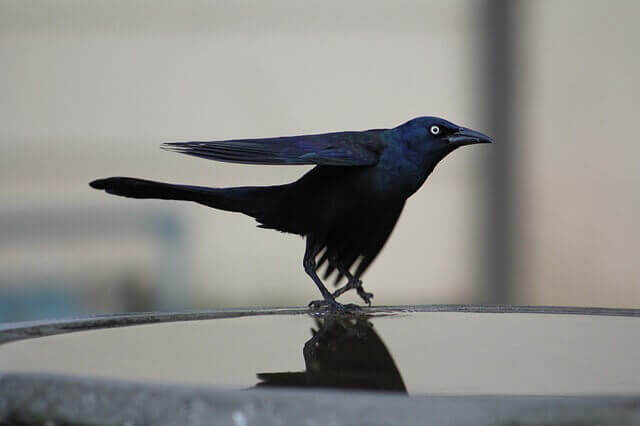
The Common Grackle (Quiscalus quiscula) is a medium-sized songbird that is found across North America. The bird has a black body with iridescent feathers on the head and neck. The wings and tail are also black. The common grackle measures about 11 to 12 inches in length and has a wingspan of 14 to 18 inches.
The common grackle is found in open habitats such as fields, marshes, and woodlands. The bird typically nests in trees, but will also nest in shrubs and on the ground. The diet of the common grackle consists of insects, earthworms, snails, and other small invertebrates. The bird will also eat fruits and berries.
- Frequency: 24.72%
- Color: Black overall with a blue, and purple iridescence. Its body plumage is a shimmering copper color.
- Habitat: Woodlands, marshes, meadows, parks, backyards, and fields
- Range: East of the Canadian Rockies, Canada and the United States
- Size: 11 – 13″ inches length
- Weight: 75 – 143 grams
- Diet: minnows, eggs, berries, seeds, grain, insects, frogs, mice.
- Family: Icteridae
- Genus: Quiscalus
- Maps: Range Map – Sightings Map
- Sounds: Calls and Songs
House Sparrow
The house sparrow is a small, brown and gray bird with a short tail and stout bill. It is found in urban and rural areas across the United States. The house sparrow is not migratory, but may move around in search of food or suitable nesting sites. The diet of the house sparrow consists mainly of seeds, but they will also eat insects, spiders, and other small invertebrates.
In urban areas, they often scavenge for food scraps. House sparrows typically nest in cavities, such as holes in trees or buildings. The house sparrow is considered to be one of the most successful introduced species of bird in North America. However, its populations have declined sharply in recent years due to habitat loss and pesticide use.
- Frequency: 23.44%
- Color: Gray head marking, a reddish-brown back, and gray underparts
- Habitat: Urban centers, suburban areas, backyards, edges, yards, and parks
- Range: North America, Central America, South America, Africa, Australia, New Zealand
- Size: 5.5 – 7.1″ inches in length
- Weight: 25 – 39 grams
- Diet: Insects, beetles, caterpillars, aphids,, grasshoppers, crustaceans, earthworms, vertebrates
- Family: Passeridea
- Genus: Passer
- Maps: Range Map – Sightings Map
- Sounds: Calls and Songs
Related: How to Attract Sparrows to your Backyard
Northern Flicker
The Northern Flicker is a member of the woodpecker family that ranges across most of North America. These birds are highly adaptable and can be found in a variety of habitats, from forests to open fields. Their diet consists mainly of insects, which they catch by foraging on the ground. Flickers are unique among woodpeckers in that they spend a significant amount of time foraging on the ground.
This behavior exposes them to predators such as hawks and coyotes, but it also allows them to take advantage of a rich food source: insects. In addition to beetles and ants, flickers also eat fruits and berries. Flickers are medium-sized birds with brown upper parts and buff underparts. They have a long tail and strong legs that enable them to perch upright on tree branches.
- Frequency: 21.58%
- Color: Light brown with black bars across back, chest, wings, belly
- Habitat: Forests, woodlands, backyards, edges, yards, and parks
- Range: North America, Central America, Cuba, Cayman Islands
- Size: 10 – 14″ inches
- Weight: 85 – 165 grams
- Diet: Insects (ants, beetles, invertebrates), fruits, seeds, berries
- Family: Picadae
- Genus: Colaptes
- Maps: Range Map – Sightings Map
- Sounds: Calls and Songs
Related: How to Attract Northern Flickers to your Backyard? (Easy)
These backyard birds below all have a frequency of less than 20%
- Gray Catbird – 20.03% Frequency
- Dark-eyed Junco 19.43%
- Chipping Sparrow 18.19%
- Fish Crow 17.20%
- Eastern Towhee 14.81%
- Brown-headed Cowbird 13.90%
- Barn Swallow 12.93%
- Common Yellowthroat 12.89%
- Pileated Woodpecker 12.51%
- Red-eyed Vireo 11.93%
- Blue-gray Gnatcatcher 11.85%
- Tree Swallow 11.50%
- Yellow-rumped Warbler 11.01%
- Eastern Phoebe 10.95%
- Chimney Swift 10.65%
- Indigo Bunting 10.29%
- Belted Kingfisher 10.20%
- Eastern Wood-Pewee 10.05%
- Hairy Woodpecker 9.20%
- House Wren 9.00%
- Cedar Waxwing 8.92%
- Rock Pigeon 8.39%
- Great Crested Flycatcher 8.34%
- Field Sparrow 8.09%
- Killdeer 7.45%
- Eastern Kingbird 7.43%
- Brown Thrasher 7.15%
- Ruby-throated Hummingbird 7.10%
- Ruby-crowned Kinglet 7.08%
- Wood Thrush 6.72%
- Swamp Sparrow 6.40%
- Northern Parula 6.27%
- American Redstart 5.69%
- Scarlet Tanager 5.26%
- Ovenbird 5.08%
- Acadian Flycatcher 5.06%
Frequently Asked Questions
What is the most common bird in Maryland?
According to eBird, the Northern Cardinal is the most common bird in Maryland, with a frequency of occurrence of 60.65%. The Northern Cardinal is a red bird with a black mask and a yellow beak. It is found in woodlands, gardens, and parks. The Northern Cardinal is not migratory and can be found in Maryland all year round.
What type of black birds are in Maryland?
There are four types of black birds that are commonly found in Maryland: the Red-winged Blackbird, Rusty Blackbird, Yellow-headed Blackbird, and Brewer’s Blackbird. All four of these species are members of the family Icteridae, which includes New World orioles and meadowlarks. The Red-winged Blackbird is the most widespread and abundant black bird in Maryland.
Are there bluebirds in Maryland?
There are two species of bluebirds in Maryland: the Eastern Bluebird and the Mountain Bluebird. The Eastern Bluebird is the more common of the two, and can be found in wooded areas throughout the state. The Mountain Bluebird is less common, but can be found in mountainous areas in western Maryland.
Do wrens live in Maryland?
There are seven species of wrens that have been documented in Maryland: Carolina Wren, House Wren, Winter Wren, Marsh Wren, Sedge Wren, Rock Wren, and Bewick’s Wren. All of these species are non-migratory, meaning they will typically stay in Maryland year-round. The Carolina Wren is the most common wren found in the state, while the Bewick’s Wren is the least common.
What large black birds are in Maryland?
There are several large black birds that can be found in Maryland. The American crow is the most common. Turkey vultures and common grackles are also fairly common in the state. Fish crows and black vultures are less common, but they can still be found in some areas. Brown-headed cowbirds are also found in Maryland, though they are not as large as some of the other black birds that can be found in the state. Common ravens are the least common large black bird that is found in Maryland.
Are there ravens in Maryland?
There are ravens in Maryland, but they are very rare. According to eBird, the frequency of occurrence of ravens in Maryland is only 2.2%. Ravens are large black birds that are members of the crow family. They are known for their intelligence and their ability to solve complex problems. Ravens are also known for their loud, harsh calls.
How many species of birds are in Maryland?
According to the Ebird, there are 494 species of birds in Maryland. This number includes both native and non-native birds. The most common bird in Maryland is the Northern Cardinal, followed by the Carolina Wren and the American Crow.
Related Post:


